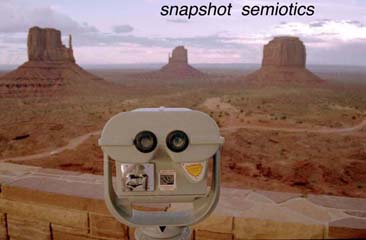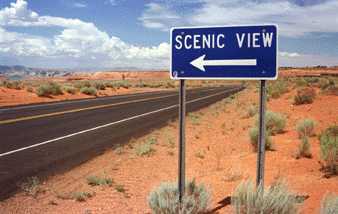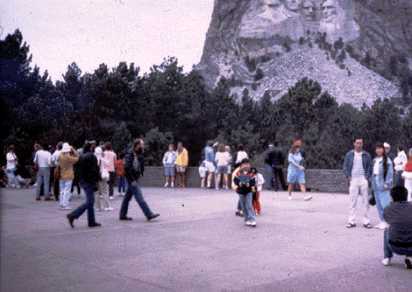
A Visual Cultural Study of Snapshot Photography, Landscape, and Tourism in the Contemporary American West

 |
A Visual Cultural Study of Snapshot Photography, Landscape, and Tourism in the Contemporary American West |
 |
My photographs are analyzable objects that show particular tourists inhabiting tourist landscapes. My captions locate them in place and in time. However, to understand the photographic practices that I have represented in my photographs, you must also understand the discursive space that I inhabit as a photographer concerned with representing the ways that people inhabit physical space. The Snapshot Semiotics Overview has shown "where I am coming from" in terms of a particular set of academic discourses, but I think it is also necessary to locate myself more personally. With that in mind, I want to tell you a touristic story about how I came to be fascinated and even "haunted" by my consciousness of my own "location" while I was at a particular tourist site. The story is a more personal narrative of the sorts of "writings" that impinge on my understanding of the tourist photographic practices represented in the photograph that appears below:

The story begins in the Black Hills of South Dakota where, as cliched as it may sound, I had a sort of epiphany one gray August day in 1991. The epiphany occurred on day five of what would be a fourteen day, 7,000-mile caffeine-paced reconnaissance trip through ten states in the West that started and ended in Salt Lake City, Utah. I decided to go on the trip while I was working in a fish fossil quarry in southwestern Wyoming for the summer. I thought I should take advantage of the proximity of Wyoming to many other western states I had not visited before. I also wanted to experience travelling "Out West" on the same time scale as the "typical tourists" I was beginning to become interested in academically.
For days I sped through Utah, Colorado, Wyoming, and Nebraska. I rarely stopped for anything but periodic photo opportunities and gas and food fill-ups, and rarely slowed down the pace except in my nightly searches for National Forest campsites. But as I approached the South Dakota border from the sand hills of Nebraska, I started to notice that the roads were becoming more and more crowded and the driving pace was becoming more and more frenetic. A rainstorm was also moving in, darkening the sky and giving an ominous feel to the whole experience. For the rest of the way, the rainy highways leading into the Black Hills were packed with vehicles that displayed cultural allegiance to the myth of the west. Caravans of RVs with names like "Frontiersman," "Caribou," "Wanderer II," and "Tioga" were travelling alongside automobiles called "Pathfinder," "Wrangler Renegade," "Cherokee," and "Explorer." Both were intermixed with bands of bikers in black leather chaps and shirts and jackets with images of eagles and cow skulls on them. I saw license plates from states as far away as Vermont, Florida, and California, and as near as Montana and Minnesota.
The parking lot at the National Monument was full, so I parked my truck next to the other vehicles parked in the impromptu overflow parking on the lawn beside the parking lot. I slipped on my raincoat and prepared to face the rain. As I grabbed my camera off the seat beside me and got out of the truck, I noticed that some bikers next to me were also grabbing their still cameras and video cameras out of their saddle bags. I decided that instead of going directly to the viewing deck I would wait out the rain inside the Visitor Center directly behind it. I wandered around the Visitor Center looking at the displays, books, and postcards, surrounded by other jostling bodies doing the same. After nearly a week of solitary travel, it felt good to commune with other tourists involved in a common endeavor. I joined the people crowding around a TV screen that was playing a video about the heroic feats involved in the production of the sculpture. Because I came in in the middle of the video, I stayed on to watch the first half when the last half was over. Before long, I noticed that the rain outside had turned to a fine mist, so I wandered out onto the designated scenic overlook (which in this case was actually a scenic underlook). I took several photos of the stone faces with my camera--photos framed the same way as the post cards I had seen earlier in the Visitor Center. The only difference was that in my pictures the sky was gray, not blue. I noticed that many of the other visitors were also taking similar pictures.
Soon, however, huge drops began pelting those of us standing on the one hundred square foot landing just below the Monument. I instantly fled to the Visitor Center, but I noticed that few of my companions were joining me. Despite the rain, the pilgrims were still drawn magnetically to the wall at the edge of the viewing platform where they alternately gazed at and photographed the stone faces, and took pictures of each other standing in front of the Monument. I crept outside again and found a spot next to the few other wimps standing under the building's awning, and watched what became for me something "photographable" as a dramatic spectacle that overshadowed the intended drama of the patriotic faces carved into the side of the granite outcropping. Perhaps it was because the rain obscured the distant view, or perhaps it was because I was traveling alone and thus had no one to pose with, but, either way, the foreground of the vista became much more interesting to me than the presented vista. The gray Monument off in the distance started to look like a huge unreal hologram or backdrop prop compared to the physicality of the people there at the underlook performing their elaborately choreographed (though apparently authorless) stageplay. As I started thinking about how all of these people had learned how to act their part in this cultural drama, I pulled out my camera again, and began taking pictures of the context surrounding what I was supposed to see instead of the thing itself.
As I stood there now taking pictures and thinking about the implications of what I was seeing, I noticed that a young Japanese-American boy had become bored with his family's posing ritual and had begun looking at me as I took pictures of people on the viewing deck. I guess I had been making more of a spectacle of myself than I had intended. Soon, the boy raised his little automatic camera and took my picture, drawing me into the scene I had been observing from afar and implicating me in the action. I was no longer an invisible passive observer, a detached post tourist. Now, as the result of a single momentary action, I had become--like the people having their pictures taken in front of the Monument and the Monument itself--something photographable according to a tourist aesthetic. |
 |
Even now I am surprised that in the rush of the "decisive moment" I had the presence of mind to quickly snap a picture of the boy as the boy "took" my picture as I "took" his picture taking my picture taking his picture, etc. The spiraling of images was dizzying to me then and still is now as I recall it and try to construct a sentence that will do it justice. The photograph I took is not very well focused and didn't really "catch" the boy in the action of taking my picture, but I have put it here because the image continues to speak to me. The boy had already started to put his camera down when I snapped my picture, but he was still looking at me. Moreover, in the picture his parents are also looking at me, wondering perhaps why their son had wasted his film, how I felt about what he had done, and whether my photographing them was hostile. I still wonder what the boy's family did with his picture of me. Did they incorporate the picture into their own family album (do they have one?) and narrate my actions as "another roadside attraction," or did they edit the picture out as an irrelevant "kid picture"? I wonder similar things about the other pictures I have taken of people looking into my camera trying to figure out what I was doing--where did they locate me?
I have told so many people this story that it has started off its own set of new meanings as my friends and students have incorporated it into their own sets of representations of touristic encounters with Mount Rushmore and with touristic landscapes in general. I began to see my experience of being implicated in the field of action as a lesson I had learned from reading Mark Klett's article, "A View of the Grand Canyon in Homage to William Bell," just before I took my trip. It would be an understatement to say that Klett's article was on my mind as I traveled. Indeed, the article was so central for me that I have titled my Mount Rushmore picture "A View of Mount Rushmore in Homage to Mark Klett."
I mention this not only to acknowledge my debts to Klett, but also to further illustrate how the process of landscape tourism works in the field for me as well as the tourists I have studied. As I began to explore the phenomenon further, I found that my experience at Mount Rushmore could serve as a case study in the ways that portions of a landscape are made both visible and meaningful for the people encountering them. Every place I visited I carried with me a set of complex legacies that I had inherited from my particular upbringing and my academic training. Learning how this worked for me as well as my "subjects" helped me understand that whether we consciously apprehend it at the site or not, all photographs of place pay homage to previous acts of inhabitation and image-making.
As I argued in the Snapshot Semiotics Overview, when we visit a landscape that has been designated a tourist landscape, we inhabit not only a landscape but also an imagescape. Just as William Bell's photographs were part of the imagescape Klett inhabited as he photographed Taroweap Point, Klett's words and images were part of the imagescape I temporarily inhabited at Mount Rushmore. They helped me notice the context that foregrounded the site, and they helped me think about ways of representing it. They helped me see my own reflection in the people I was studying as well. They did not "cause" or "determine" my epiphany in any simplistic sense, but they did highlight things that I had not yet learned to articulate. My role in doing the present study is to further that process of highlighting. I hope to add my modest input to the imagescape that my readers will inhabit if they visit one of the sites under discussion after temporarily inhabiting my text, or even if they do not.
But, more important, my picture of the boy at Mount Rushmore has served as a constant reminder to me that while I was "studying" this phenomenon as an academic, I was also thoroughly implicated in it. I started this project bewitched by Baudrillardian explanations for the role of images in postmodern culture. As a self-consciously ironic post-tourist, I reveled in the idea that the landscapes tourists were visiting had been rendered hyperreal by their long history of representations. Like DeLillo's Murray, I gained power from that knowledge, and congratulated myself for being detached enough from those unfortunates who were mistaking a presented nature for nature itself. The obverse of the satisfaction I felt when I "understood" tourism this way was the solace I took in knowing of and seeking out places off the beaten trail where I could find authentic nature in its raw unmediated form. When I went to tourist sites I thought of myself as a disembodied tourist of tourism, but when I went camping, backpacking, or hiking off the beaten trail I thought of my self as an entirely embodied wilderness adventurer. The longer I inhabited this discourse and the more time I spent at tourist sites, however, the more I began to understand the limitations of nihilistic postmodernism as a strategy for both being-in-the-world and for studying the ways that others do the same. And as I started looking around me I found more people like myself who were trying to teach themselves and others the same lessons I was trying to teach myself every time I looked at that Mount Rushmore picture hanging on my wall.
|
Design, Photography, and Text © 2001 by Bob Bednar
Department of Communication
snapshot semiotics home | overview | portfolio | shadows and reflections | caught looking | deconstructing nature/culture |
 |
A Visual Cultural Study of Snapshot Photography, Landscape, and Tourism in the Contemporary American West |
 |